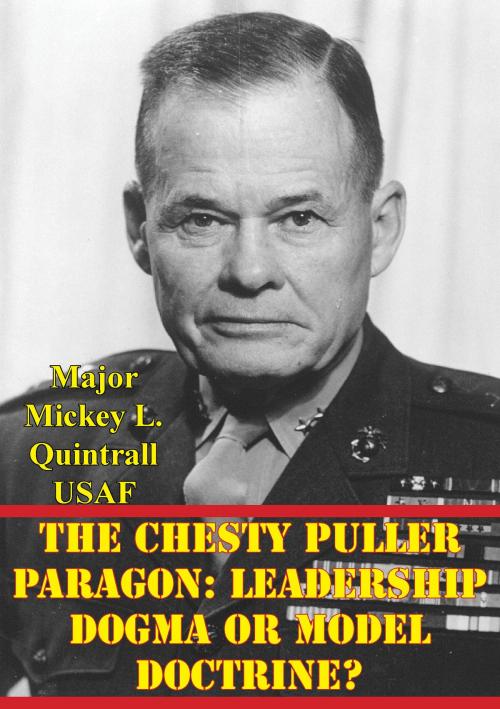The Chesty Puller Paragon: Leadership Dogma Or Model Doctrine?
Nonfiction, History, Germany, European General, Military, United States| Author: | Major Mickey L. Quintrall USAF | ISBN: | 9781786250759 |
| Publisher: | Lucknow Books | Publication: | November 6, 2015 |
| Imprint: | Lucknow Books | Language: | English |
| Author: | Major Mickey L. Quintrall USAF |
| ISBN: | 9781786250759 |
| Publisher: | Lucknow Books |
| Publication: | November 6, 2015 |
| Imprint: | Lucknow Books |
| Language: | English |
In this study, I examine whether or not the United States Marine Corps senior warrior-leaders should continue to use heroic-warriors from the 1942-52 era as contemporary paragons of tactical leadership. Additionally, I compare the Marine tactical leadership models between 1942-52, and their relevance within the cultivated and refocused leadership doctrine of today’s Marine Corps. Then, I examine whether or not there is a gap created using an earlier era’s tactical leadership example to model contemporary tactical battlefield leadership.
The Marine Corps tactical leadership criteria and what the Corps expected of its commanders during World War II and the Korean War is the starting point. There was not much written leadership guidance then, but there was accepted leadership doctrine, nonetheless. Today, several United States Marines are recognized as setting the contemporary paragon for the ideal tactical battlefield leader. Among them, is World War II and Korean War Marine Lewis “Chesty” Burwell Puller. Chesty Puller not only set a courageous combat example, he trained his men hard, respected his men’s fearlessness, and worked hard to build unit comradeship.
Service parochialism and cultural turmoil through the Vietnam War set the stage for a rocky period in the history of the Corps, leading up to the Commandant’s re-focus on a new Marine followership-leadership ethos. The Marine Corps’ recent efforts to “Transform” their Marines into a new breed is an attempt to transform leadership dogma to leadership-followership doctrine. His fresh approach is thought to better inculcate the Marine culture with loyalty and commitment to the Corps, similar to what was experienced within World War II Marine Corps.
The thrust of the monograph pursues the question: Does Chesty Puller provide the right contemporary leadership example, or does he perpetuate dogma?
In this study, I examine whether or not the United States Marine Corps senior warrior-leaders should continue to use heroic-warriors from the 1942-52 era as contemporary paragons of tactical leadership. Additionally, I compare the Marine tactical leadership models between 1942-52, and their relevance within the cultivated and refocused leadership doctrine of today’s Marine Corps. Then, I examine whether or not there is a gap created using an earlier era’s tactical leadership example to model contemporary tactical battlefield leadership.
The Marine Corps tactical leadership criteria and what the Corps expected of its commanders during World War II and the Korean War is the starting point. There was not much written leadership guidance then, but there was accepted leadership doctrine, nonetheless. Today, several United States Marines are recognized as setting the contemporary paragon for the ideal tactical battlefield leader. Among them, is World War II and Korean War Marine Lewis “Chesty” Burwell Puller. Chesty Puller not only set a courageous combat example, he trained his men hard, respected his men’s fearlessness, and worked hard to build unit comradeship.
Service parochialism and cultural turmoil through the Vietnam War set the stage for a rocky period in the history of the Corps, leading up to the Commandant’s re-focus on a new Marine followership-leadership ethos. The Marine Corps’ recent efforts to “Transform” their Marines into a new breed is an attempt to transform leadership dogma to leadership-followership doctrine. His fresh approach is thought to better inculcate the Marine culture with loyalty and commitment to the Corps, similar to what was experienced within World War II Marine Corps.
The thrust of the monograph pursues the question: Does Chesty Puller provide the right contemporary leadership example, or does he perpetuate dogma?




![Cover of the book On The Road To Kut, A Soldier’s Story Of The Mesopotamian Campaign [Illustrated Edition] by Major Mickey L. Quintrall USAF](https://www.kuoky.com/images/2014/june/300x300/9781782891758-zjOL_300x.jpg)

![Cover of the book 48 Million Tons To Eisenhower: The Role Of The SOS In The Defeat Of Germany [Illustrated Edition] by Major Mickey L. Quintrall USAF](https://www.kuoky.com/images/2015/november/300x300/9781786257666-m0lC_300x.jpg)
![Cover of the book Eye Witness’s Narrative Of The War From The Marne To Neuve Chapelle 1 September, 1914-March 1915 [Illustrated Edition] by Major Mickey L. Quintrall USAF](https://www.kuoky.com/images/2015/november/300x300/9781786255594-V3rY_300x.jpg)







